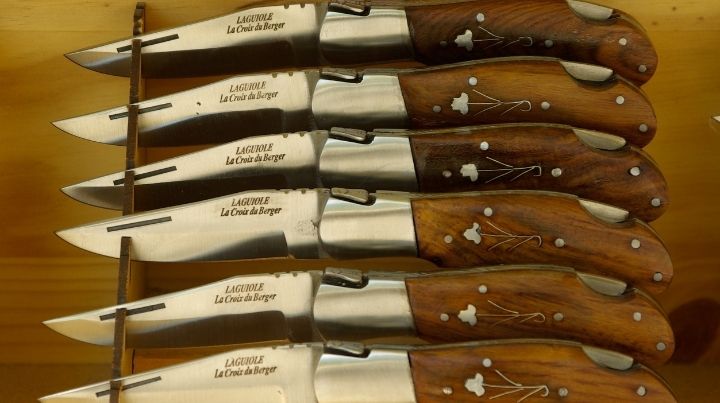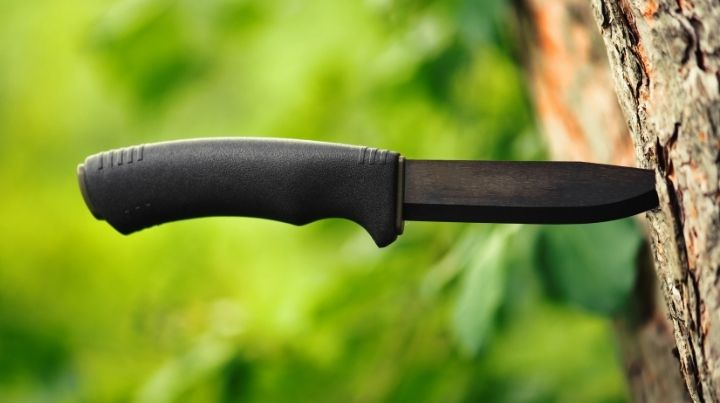7 Best Ways: How to Sharpen a Knife Without a Sharpener
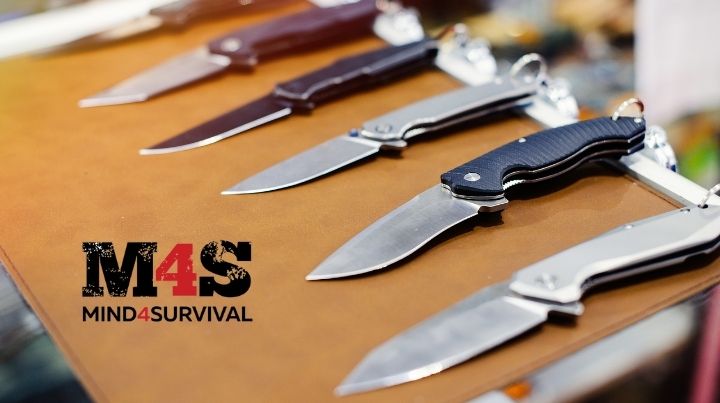
Knives are an essential part of every preparedness-minded person’s gear. Therefore, it’s vital to know how to sharpen a knife without a sharpener.
This article will provide an overview of how to sharpen knives using everyday objects that you may have in an emergency.
How Knives Go Dull and How to Prevent It
It is essential to know how knives go dull and how to prevent that from happening because a sharp knife is safer and more effective to use.
Dull knives are more likely to slip and cause accidents.
Dull knives are also less effective because they require more force to cut through things, which can fatigue your hand and arm.
Disclaimer: This article contains affiliate links, for which I may receive a small commission at no cost to you if you choose to purchase a product through a link on this page.
How Knives Go Dull 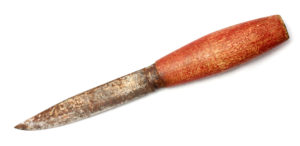
There are many reasons why knives go dull. The three leading causes of blade wear are metal fatigue, abrasion, and corrosion.
Metal fatigue is the result of using the knife repetitively. The metal will start to crack and form small chips around the blade’s edge.
Abrasion happens when two surfaces rub against each other knife’s, knife’s edge will slowly wear down as it rubs against whatever it is cutting.
Corrosion is a chemical reaction that can happen when the blade comes into contact with moisture. Salty or acidic foods can cause the blade to rust over time.
How to Prevent Knives from Dulling
There are several ways to prevent your knives from dulling.
Keep your knives dry and clean. Do not let them come into contact with moisture or food acids.
Use a cutting board. Cutting on a hard surface, like granite or metal, can cause abrasion. A cutting board will help to protect the blade from wear.
Use the correct knife for the job.
A serrated knife is not meant to cut through thin items like vegetables. Its blade will wear down more quickly than a smooth-edged knife.
Get your knives sharpened professionally regularly. This is the best way to keep them in good condition and prevent dulling.
The Best Ways to Sharpen a Knife Without a Sharpener
If you are a prepper or survivalist, you know the importance of sharpening knives. In an emergency, that applies to how do you sharpen your blade without a sharpener?
Knives can go dull for many reasons, and there isn’t always an opportunity to get them sharpened professionally.
Several ways don’t require any tools at all!
1. How to Sharpen a Knife on a Car Window
If you’re ever in a bind and need to sharpen your knife, you can use the glass of your car window.
Just hold the knife so that the car window edge matches the blade angle of your knife (approximately 20 degrees) and run it down the length of the top, uncoated glass edge.
Make an equal number of passes on each side of the blade until your newly sharpened knife is ready to go.
Make sure to keep your fingers clear of the blade when sharpening.
2. How to Sharpen a Knife with a Ceramic Coffee Mug
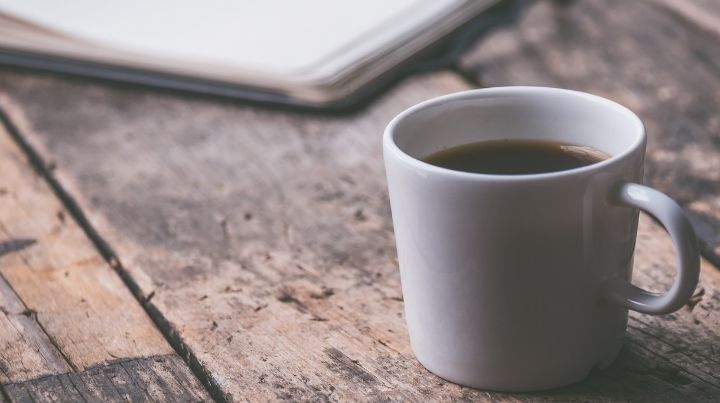
If you don’t have a sharpening stone and are done with your morning cup of goodness, you can use a ceramic coffee mug to keep your knife sharp.
The best way to do this is to begin by turning your ceramic mug upside down onto a safe and stable surface.
Turning the upside-down will expose the unglazed rim on the bottom of the cup.
With your upside-down coffee mug secure, use the same sharpening technique discussed when using your window’s edge to sharpen your survival knives.
Match the knife’s edge to the ceramic mug and draw it across the ceramic an equal number of times on each side until you achieve your desired sharpness.
3. How to Sharpen a Knife with a File
If you have a file, you can use it to sharpen your knife. Fine industrial files work, and so too will a nail file.
The best way to use a file is to place the file on a flat surface, and as with the other methods of sharpening your blunt knives, match the edge (~20 degrees) and draw the knife along the file.
4. How to Sharpen a Knife with a Knife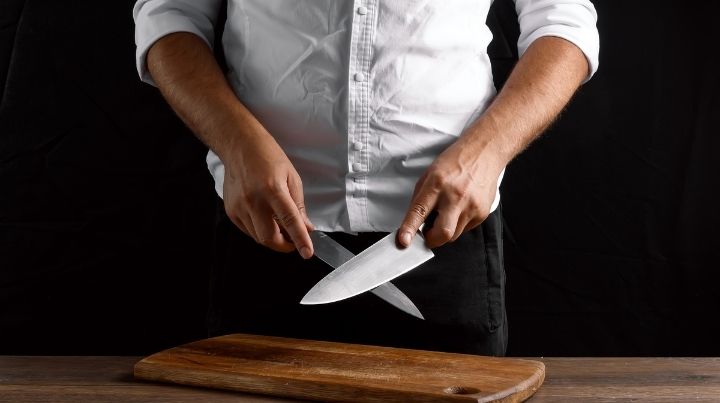
If you have two knives, you can use the second knife to sharpen the other.
Take the knife that you want to sharpen and, while keeping an eye on the angle, run it along the spine of the other blade.
Continue the process until your knife is sharp and ready for work.
5. How to Sharpen a Knife with a Rock
If you don’t have a sharpener, you can use a flat rock with a slightly rough surface as your homemade sharpening stone.
The best rock to use is a river stone.
Use the same techniques of matching the same angle of your blade to the stone and repeatedly sharpening each side of your knife.
6. How to Sharpen a Knife With Sandpaper
If you have some sandpaper lying around, you can use it to sharpen your blunt blade.
The best way to do this is to lay the sandpaper flat on a hard surface and match the edge.
Rub the blade along the sandpaper in a back-and-forth motion.
You will need to switch to finer sandpaper if the knife becomes dull.
7. How to Sharpen a Knife with a Glass Bottle
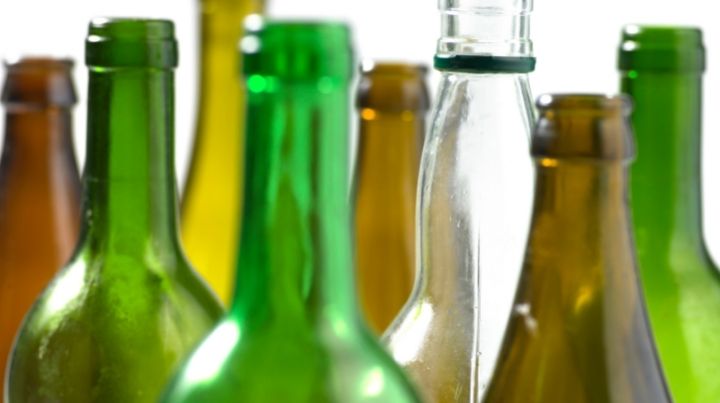
If you don’t have anything else to sharpen your knife, you can use a glass bottle instead.
Before anyone asks, no, you shouldn’t use a broken glass bottle to sharpen your knife.
The best way to do this is to hold the bottle flat, and again, matching the angle of your knife edge, drag your blade back and forth over the bottle.
8. How to Sharpen a Knife with a Metal Pipe
If you have a metal pipe, you can use it to sharpen your knife.
The best sharpening process involves finding a flat surface, holding the pipe at the right angle to match your blade, and then going to town to get your knife quickly sharpened.
Then, rub the blade along the pipe in a back-and-forth motion.
9. How to Sharpen a Knife with a Leather Belt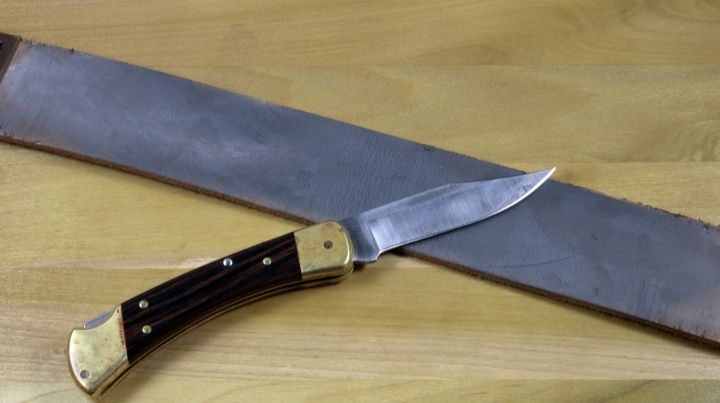
If you don’t have a better option, you can use a leather belt to sharpen the cutting edge of your knife.
Think about barbers who sharpen their straight razors on a leather strap. It’s the same dull blade sharpening concept for an old belt.
The best way to do this is to hang one end of the belt and pull down the other.
Then, while matching the angle of the blade, rub the blade against the belt in a back-and-forth motion until sharp.
How to Sharpen a Knife With a Purpose-Built Knife Sharpener
There are various purpose-built knife sharpening methods for taking care of your dull knife.
1. How to Sharpen Your Knife with Waterstones
Waterstones are sharpening stones that you can find at most hardware stores.
You will need to soak the stones in water for 10-15 minutes to use them.
Then, place the stones on a flat surface and hold the knife at a 20-degree angle.
Rub the knife blade along the stone in a back-and-forth motion.
2. How To Sharpen A Knife With A Whetstone
Whetstones, such as the Sharp Pebble Premium Whetstone, are another sharpening stone that can sharpen knives. They are usually oval-shaped and come in different grits (coarseness).
To use a whetstone, you must soak it in water for 10-15 minutes.
Then, place the whetstone on a flat surface and hold the knife at a 20-degree angle.
Rub the blade along the whetstone in a back-and-forth motion.
3. How to Sharpen a Knife with a Diamond Stone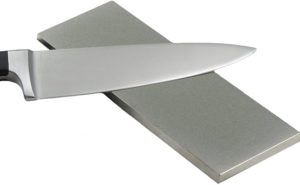
Diamond stones are the most expensive type of sharpening stone. If you’re in the market for an excellent diamond stone set, take a look at the highly-rated Ultra Sharp Diamond Sharpening Stone Set.
To use a diamond stone, you need to soak it in water for 10-15 minutes.
Then, place the diamond stone on a flat surface and hold the knife at a 20-degree angle.
Rub the blade along the diamond stone in a back-and-forth motion.
4. How to Sharpen a Knife with a Ceramic Stone
Ceramic stones are the most popular type of sharpening stone. They are affordable and can be found at most hardware stores and Amazon, such as the Suehiro CERAX Ceramic sharpening stone.
To use a ceramic stone, you will need to soak it in water for 10-15 minutes.
Then, place the ceramic stone on a flat surface and hold the knife at a 20-degree angle.
Rub the blade along the ceramic stone in a back-and-forth motion.
5. How to Sharpen a Knife with a Sharpening Rod
Sharpening rods, such as the TUO Honing Steel sharpener, are the most common type of sharpening tool found in most knife stores.
To use a sharpening rod, you will need to place the rod on a flat surface and hold the knife at a 20-degree angle.
Rub the blade along the sharpening rod in a back-and-forth motion.
Knife Sharpening Tips
1. Use a Purpose Made Sharpening Stone
The best way to sharpen your knives is with a sharpening stone. Make sure to use a sharpening stone that is the right size for your blades.
2. Use a Honing Rod
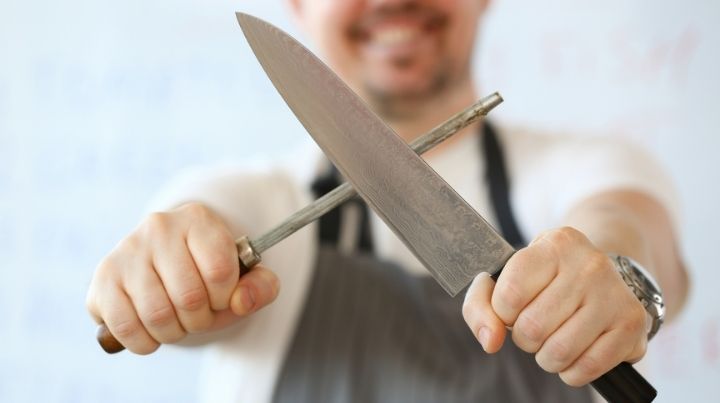
Use a honing rod to keep your knives sharp between sharpenings. A honing rod is a metal rod used to realign the blade of the knife.
A honing rod is not a substitute for sharpening stones, but it can help to keep your knives in good condition.
3. Use the Right Angle
When sharpening your knives, make sure to use the 20-degree angle. This is the angle that is most effective for sharpening knives.
4. Use a Steady Motion
When sharpening your knives, make sure to use a steady motion. This will ensure that you get the most out of your sharpening stone.
10 Tips and Tricks for Keeping Your Knives in Good Condition
Keeping your knives sharpened and in good condition is vital for safety and efficiency.
Follow these nine tips to get the most out of your knives:
1. Keep Your Knives Clean and Dry 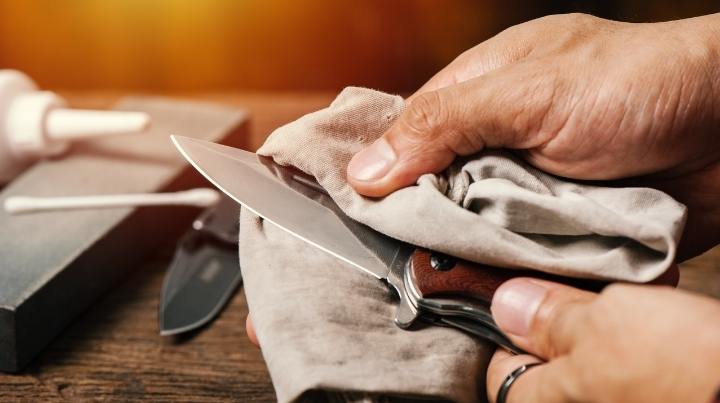
Dirty blades will become dull faster. Make sure to clean your knives after each use and dry them off thoroughly.
2. Use the Right Knife for the Job
Using the wrong knife for the job will quickly cause it to become dull. Make sure to use the right knife for the task at hand.
3. Sharpen Your Knives Regularly
If you don’t sharpen your knives regularly, they will become dull. Make sure to sharpen your regularly used knives at least once a week.
4. Store Your Knives in a Dry Place
If you store your knives in a moist environment, they will rust. Make sure to keep them in a dry place when not in use.
5. Store Your Knives in a Safe Place
Make sure to store your knives in a safe place where they will not be accessible to children or pets.
6. Be Careful When Handling Knives
Always be careful when handling knives. Accidents can happen quickly and easily.
7. Be Mindful of What You Cut
Don’t use your knives to cut hard objects (like bones) or chop through thick materials (like wood). This can damage the blade and make it difficult to sharpen.
8. Be Patient and Take Your Time When Sharpening Knives
Rushing through the process will result in a duller blade. Take your time and be patient when sharpening your knives.
9. Hire a Pro
If you have difficulty sharpening the knife on your own, you can take it to a professional for sharpening. However, this will be more expensive than doing it yourself.
The Bottom Line on Sharpening a Knife Without a Sharpener
Knives are an essential survival tool, and you can use them for various purposes.
However, if they’re not sharpened correctly, they can become dull, ineffective, and dangerous. In this article, we have outlined several methods that you can use to sharpen knives without a sharpener.
We’ve also discussed how knives go dull in the first place and how to prevent it.
Finally, I’ve provided a few tips and tricks for keeping your knives sharpened and in good condition.
Additional Resources:
- Personal Safety and Security Tips
- What’s the Best Weapon for Prepper Home Defense?
- Here’s the Essential SHTF Survival Gear You Need
- Best Survival Axe for 2022
Stay safe! Stay sharp!

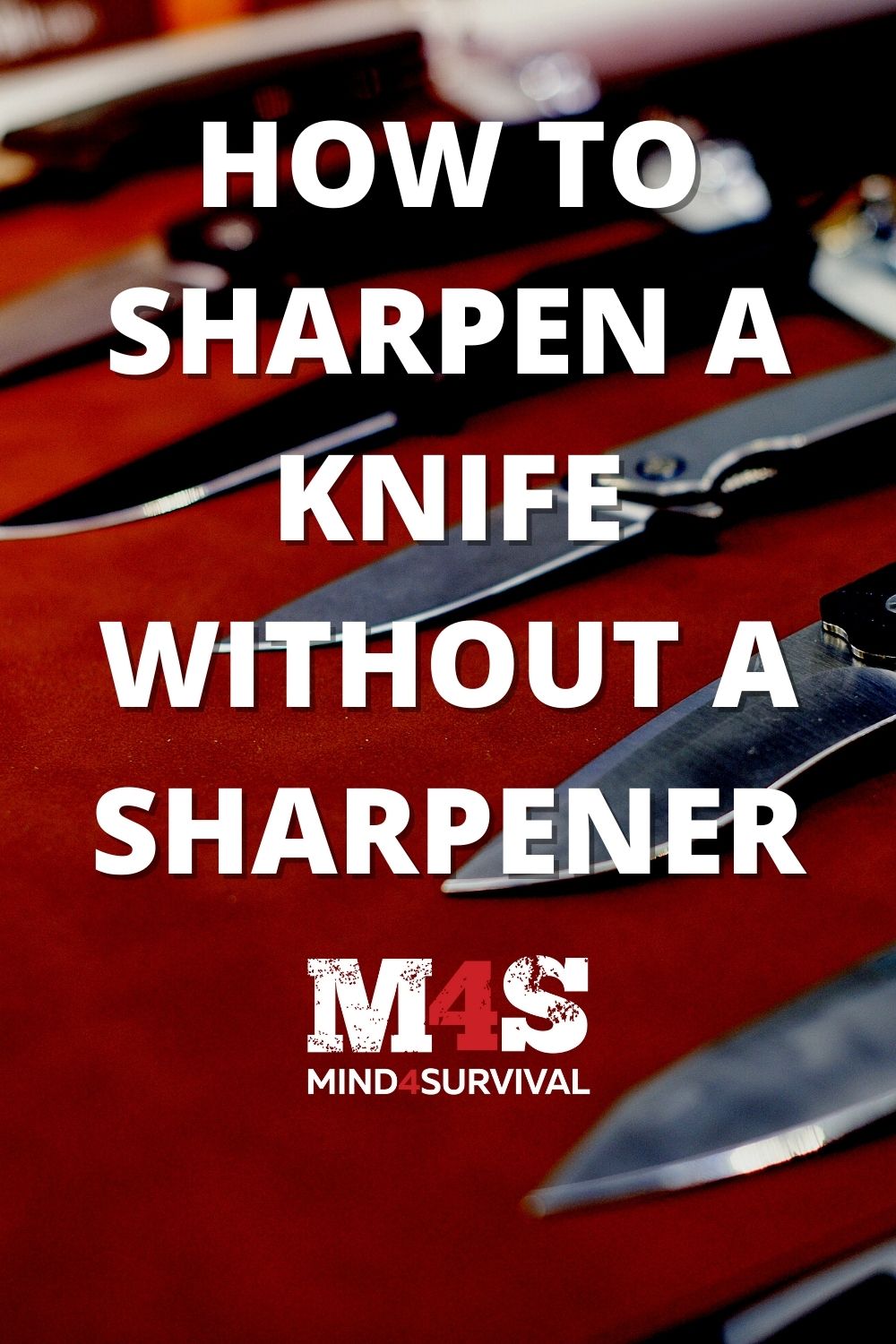
Don't Miss Out!
Join the thousands of people who rely on Mind4Survival preparedness advice by subscribing to our FREE newsletter.
- Practical preparedness information
- Zero Spam
- < 0.25% of people unsubscribe




Join Mind4Survival!
Stay informed by joining the Mind4Survival! 100% Secure! 0% Spam!
Follow Us!
Affiliate Disclosure
Mind4Survival is a free, reader-supported information resource. If you make a purchase through our link, we may, at no cost to you, receive an affiliate commission.




